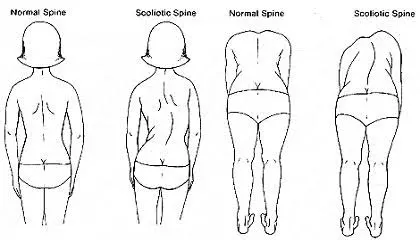Scoliosis is an abnormal sideways curve in the spine. Normally the spine has a straight alignment when seen from the front or back. A sideways curve in the spine can develop due to a various reasons at different stages of growth. As the spine grows taller, there is a tendency for the curves to worsen and can become severe by the time the kid reaches skeletal maturity. The most important factor that may help reduce the severity of the problem is early detection and treatment. The risks involved in surgical correction of a severe curve are much more than in a smaller curve detected much earlier.
There are a few indicators that can be observed by the parents of the kids, that should raise a suspicion of a spinal deformity. Normally, when a child is standing straight, the shoulders are at same level, the spine appears straight, the waist lines are symmetrical and the pelvis is level with the ground. The chest walls appear symmetrical both from the front and back.
In the presence of a curve in the spine, there are changes in the appearance of the shoulder levels, back, chest wall and waist line. There may be a slight difference in the level of shoulders. The waist line may appear a bit assymmetric and there may be additional waist creases on one side. The pelvis may appear tilted to one side and the gap between the rib cage and pelvis on the sides may appear reduced on one side.
The curve in the spine pushes the ribs backwards on one side and leads to a bump in the back – known as rib hump. This rib hump becomes more prominent when the child bends forwards. This forward bending test is routinely used by clinicians as a screening test for scoliosis. This is a very simple test that can be done by any trained healthcare worker and can be taught easily to teachers and parents so that these deformities are brought to notice at an early stage. Many countries have school screening programmes by the government, conducted by trained healthcare workers to identify those with scoliosis early and report to the spine specialists.
If parents notice any such changes in their kid, they should get an opinion from a spine specialist and seek an evaluation if necessary. Usually the first thing that is done in those with positive clinical findings is an X-ray of the spine in standing posture. Treatment depends on the cause, type and severity of the curve. Milder curves may just need a regular followup with x rays at 3 to 6 month intervals. Other options like a cast or brace may be suggested for some and some situations may need a surgical intervention.


With years of experience in spine surgery, Dr Phani Kiran S, Senior Consultant Spine Surgeon will assess you and suggest the treatment option that is right for you.
We at Medspine clinics, understand the importance of educating all our patients about the spinal problems and the most effective ways to take care of their spine.
The Ortho Clinic: Monday, Wednesday, Friday, Saturday.
Ojas Health: Tuesday, Thursday
© Copyright 2024 MedSpine. All Rights Reserved. Build with 🤍 by Digital GYB
WhatsApp us